Olympus M.Zuiko Digital ED 75-300mm f/4.8-6.7 II Lens Review
Olympus M.Zuiko Digital ED 75-300mm f/4.8-6.7 II Performance
Sharpness delivered by this lens at 75mm and maximum aperture is outstanding across the frame. Stopping down the aperture actually results in a gradual reduction in clarity as the diffraction limit of the sensor is reached. Performance across the frame is very similar at 150mm, albeit with slightly reduced clarity when compared to 75mm.Finally, at 300mm, as you might expect from a 4x zoom lens, overall sharpness across the frame is reduced compared to results at shorter focal lengths. At f/6.7 sharpness is good in the centre of the frame, but can only be considered fairly good towards the edges of the frame. Peak sharpness across the frame for this focal length is achieved at f/8. Here sharpness in the centre of the frame is very good, but the clarity recorded towards the edges of the frame is still only fairly good.
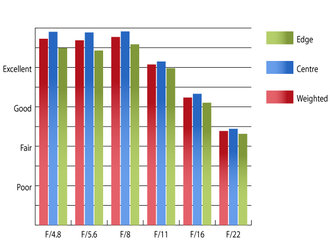 Resolution at @ 75mm | 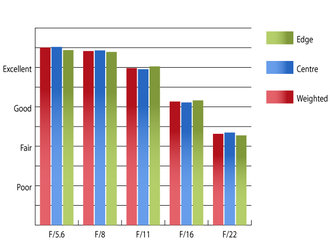 Resolution at @ 150mm | |
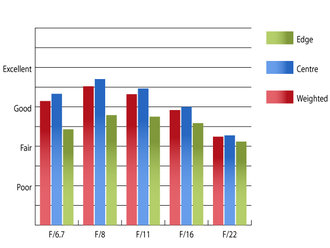 Resolution at @ 300mm | How to read our chartsThe blue column represents readings from the centre of the picture frame at the various apertures and the green is from the edges. Averaging them out gives the red weighted column.The scale on the left side is an indication of actual image resolution. The taller the column, the better the lens performance. Simple. For this review, the lens was tested on a Panasonic Lumix DMC-G3 using Imatest. |
Chromatic aberrations towards the edges of the frame are very well controlled between 75mm and 150mm. There is a noticeable increase in colour fringing towards the edges of the frame at 300mm. The increase in CA levels is such that it may become an issue, especially when photographing images with high contrast towards the edges of the frame.
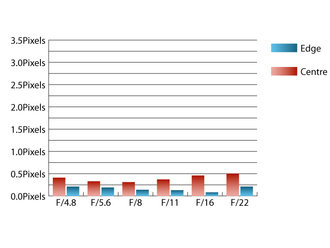 Chromatic aberration @ 75mm | 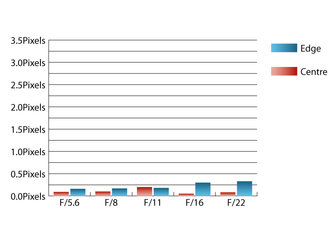 Chromatic aberration @ 150mm | |
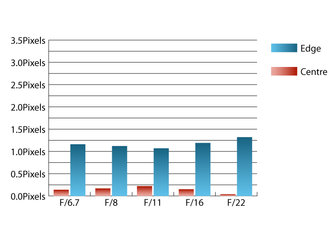 Chromatic aberration @ 300mm | How to read our chartsChromatic aberration is the lens' inability to focus on the sensor or film all colours of visible light at the same point. Severe chromatic aberration gives a noticeable fringing or a halo effect around sharp edges within the picture. It can be cured in software.Apochromatic lenses have special lens elements (aspheric, extra-low dispersion etc) to minimize the problem, hence they usually cost more. For this review, the lens was tested on a Panasonic Lumix DMC-G3 using Imatest. |
Falloff of illumination towards the corners of the frame reasonably well controlled. Corners are roughly one stop darker than the image centre at maximum aperture throughout the zoom range and visually uniform illumination is achieved by f/8 at 75mm and f/11 at 300mm.
Distortion is well controlled and very consistent through the entire zoom range. Imatest detected between 0.266% and 0.216% pincushion distortion. This low level shouldn't be too visible in normal photography. The distortion pattern is uniform across the frame, which should make applying corrections in image editing software afterwards straightforward if absolutely straight lines are paramount.
No lens hood is supplied as standard with this lens, but as this lens is equipped with Olympus' ZERO optical coatings, it is also very resistant to flare and contrast remains good, even when shooting into the light.
Add your message
Login required
Please login here or if you've not registered, you can register here. Registering is safe, quick and free.
Please login here or if you've not registered, you can register here. Registering is safe, quick and free.
photodo Stats
1102 lenses
428 MTF tests
74 in-depth photodo reviews
100+ users join each day
Help the lens community by reviewing or rating a lens today via our lens search
428 MTF tests
74 in-depth photodo reviews
100+ users join each day
Help the lens community by reviewing or rating a lens today via our lens search
Latest Lens Reviews
- Chinon 28mm f/2.8 Vintage Lens Review
- Canon EF 70-200mm f/4L IS II USM Lens Review
- Samyang AF 85mm f/1.4 EF Review
- Sigma 70mm f/2.8 DG Macro Art Review
- Samyang AF 24mm f/2.8 FE Review
- Meike 50mm f/1.7 Review
- Tamron 70-210mm f/4 Di VC USD Review
- Lensbaby Burnside 35mm f/2.8 Review
- Asahi Super Takumar 50mm f/1.4 Review
- Asahi Super-Multi-Coated Takumar 135mm f/3.5 Review
